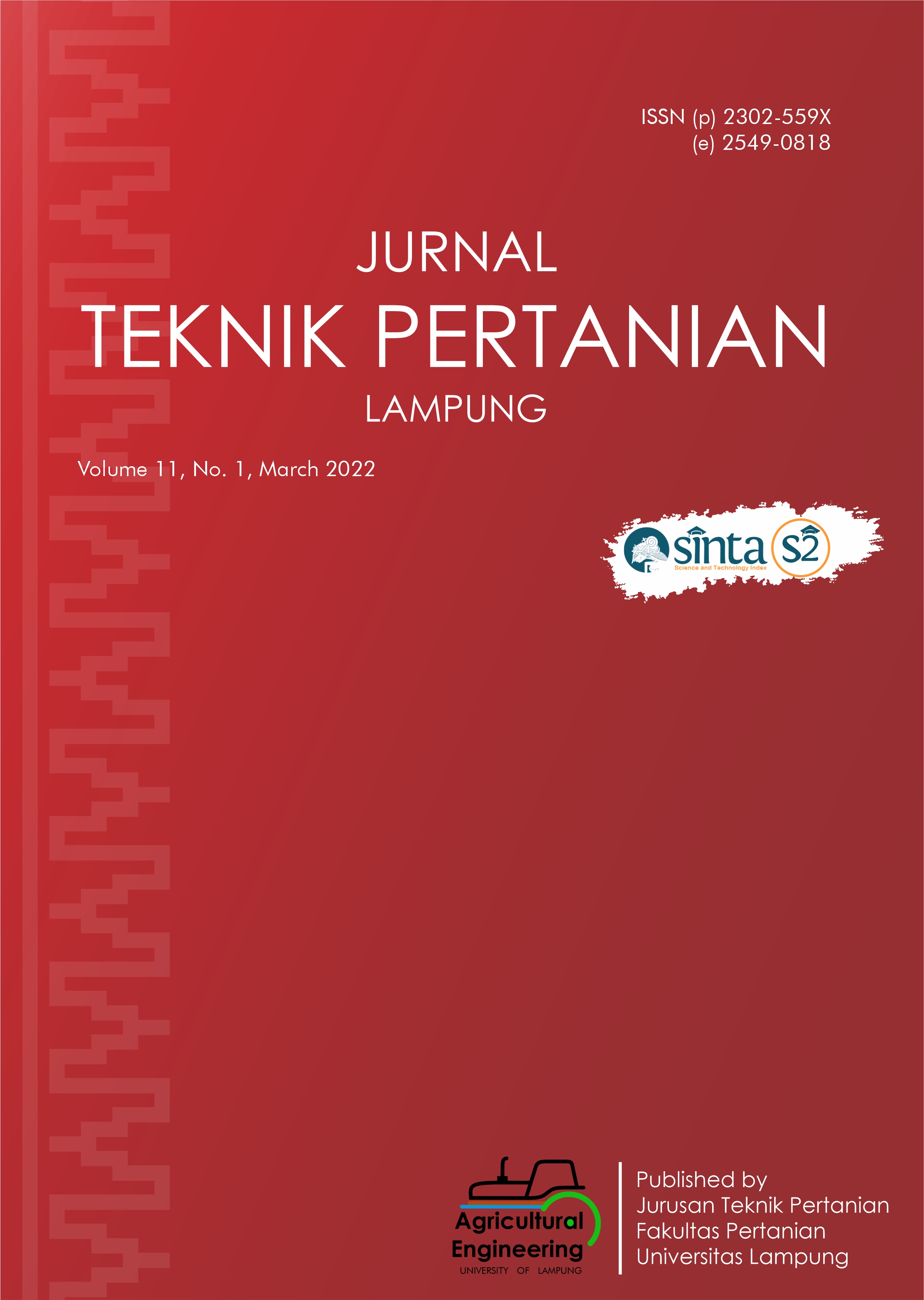Effect of Extreem Rainfall Pattern on The Growth and Yield of Chili Peppers
DOI:
https://doi.org/10.23960/jtep-l.v11i1.117-129Abstract
The purpose of this study was to observe the effect of extreme rainfall patterns in the DI Yogyakarta region on the growths of rawit/cayenne (Capsicum frutescens L.) and keriting/curly (Capsicum annum) chili peppers. The experimental design used was Randomized Complete Block Design (RCBD) with single factor consisting of three levels namely: maximum frequency index (P1), rainfall intensity index (P2), and control treatment (K). The frequency and intensity indexes (P1 and P2) of May-June-July from each weather station were used as the bases of rainfall simulations applied in watering the rawit and keriting chili pepper cultivations. Whilst, control (K) was the watering on the basis of optimum crop water requirement. The growth parameters observed included plant height, number of leaves, age of flowering, age of fruiting, age of first harvest, final weight of biomass, and yield. The data sets were analyzed by using one-way Analysis of Variance (ANOVA) at ±=0.05 for each species. The results showed that the three levels of treatments did not significantly affect the growth and yield based on all parameters observed for both of the two species. So even the potted media were flooded, the water easily drained through the holed base of pots, making plant growth undisturbed. This finding suggested that planting chili peppers in pots or elevated media could mitigate the effect of extreme rainfalls.
Keywords: Extreme Precipitation, Extreme Indices, Plant Growth, chili pepper
References
Alexander, L. V., Zhang, X., Peterson, T.C., Caesar, J., Gleason, B., Klein Tank, A.M.G., Haylock, M., Collins, D., Trewin, B., Rahimzadeh, F., Tagipour, A., Rupa Kumar, K., Revadekar, J., Griffiths, G., Vincent, L., Stephenson, D.B., Burn, J., Aguilar, E., Brunet, M., Taylor, M., New, M., Zhai, P., Rusticucci, M. & Vazquez-Aguirre, J.L. 2006. Global observed changes in daily climate extremes of temperature and precipitation. Journal of Geophysical Research Atmospheres, 111(5).
Ashari, H., Hanif, Z. & Supriyanto, A. 2015. Kajian Dampak Iklim Ekstrim Curah Hujan Tinggi (La-Nina) Pada Jeruk Siam (Citrus Nobilis var. Microcarpa) Di Kabupaten Banyuwangi, Jember Dan Lumajang. Planta Tropika: Journal of Agro Science, 2(1): 49–55.
BMKG. 2010. Peraturan Kepala BMKG Tentang Prosedur Standar Operasional Pelaksanaan Peringatan Dini, Pelaporan, dan Desiminasi Informasi Cuaca Ekstrim. Nomor: KEP.009
Bakker, Derk. 2021. Fact Sheet Waterlogging. http://soilquality.org.au/factsheets/waterlogging. Accessed at 8 Juni 2021.
Insani NN, Darmanti S., dan Saptiningsih E. 2021. Pengaruh Durasi Penggenangan Terhadap Pertumbuhan Vegetatuf dan Waktu Berbunga Cabai Merah Keriting (Capsicum annum L.) Varietas Jacko. Buletin Anatomi dan Fisiologi (Bulletin Anatomi and Phisiology), 6(2): 104-114.
IPCC. 2012. Managing the Risks of Extreme Events and Disasters to Advance Climate
Change Adaptation. A Special Report of Working Groups I and II of the
Intergovernmental Panel on Climate Change [Field, C.B., V. Barros, T.F. Stocker, D. Qin, D.J. Dokken, K.L. Ebi, M.D. Mastrandrea, K.J. Mach, G.-K. Plattner, S.K. Allen, M. Tignor, and P.M. Midgley (eds.)]. Cambridge University Press, Cambridge, UK, and New York, NY, USA, 582 pp.
Kong, D.L., Lü, X.T., Jiang, L.L., Wu, H.F., Miao, Y. & Kardol, P. 2013. Extreme rainfall events can alter inter-annual biomass responses to water and N enrichment. Biogeosciences, 10(12): 8129–8138.
Lassa, J. 2012. Emerging ‘Agricultural Involution’ in Indonesia: Impact of Natural Hazards and Climate Extremes on Agricultural Crops and Food System. Economic and Welfare Impacts of Disasters in East Asia and Policy Responses, (December): 497–545
Misnawati and Perdanawanti, M. 2019. Trend of Extreme Precipitation over Sumatera Island for 1981-2010. Agromet, 33(1): 41–51.
Meilin, A. 2014. Hama dan Penyakit Tanaman Cabai Serta Pengendaliannya. BPTP Jambi. Jambi.
National Academies of Science, Engineering, and Medicine. 2016. Attribution of Extreme Weather Events in the Context of Climate Change. The National Academies Press. Washington DC. https://doi.org/10.17226/21852.
Nugroho, Bayu DA. 2016. Fenomena Iklim Global, Perubahan Iklim, dan Dampaknya di Indonesia. Gadjah Mada University Press. Yogyakarta.
Nugroho, Sigit. 2008. Dasar-Dasar Rancangan Percobaan Edisi 1. UNIB Press. Bengkulu.
Safrizal, Santosa, E. & Bakhtiar. 2008. Pengaruh Penggenangan Terhadap Pertumbuhan Vegetatif Cabai. J.Floratek, 3: 61–67.
Santoni, G. A., Arsensi, I., & Mahdalena, M. (2019). Pengaruh Perlakuan Jarak Tanam dan Pemberian Ekstrak Daun Mahkota Dewa Sebagai Penghambat Perkembangan Penyakit Antraknosa Pada Tanaman Cabai (Capsicum annum L). Agrifarm: Jurnal Ilmu Pertanian, 5(1), 11-16. https://doi.org/10.24903/ajip.v5i1.469
Semangun, H. 2007. Penyakit-Penyakit Tanaman Hortikultura di Indonesia. Gadjah Mada University Press. Yogyakarta.
Sosrodarsono, S., and Takeda, K. 1977. Hidrologi untuk Pengairan. Dainippon Gitakarya Printing. Jakarta
Susilawati, Suwignyo, R.A., Munandar & Hasmeda, M. 2012. Irigasi Tetes pada Budidaya Cabai. Jurnal Agronomi Indonesia, 40(3): 196–203.
Supriadi DR, Susila AD, dan Sulistiyono E. 2018. Penetapan Kebutuhan Air Tanaman Cabai Merah (Capsicum amnum L.) dan Cabai Rawit (Capsicum frutescens L.). Jurnal Hortikultur Indonersia, 9(1):38-46.
Downloads
Published
Issue
Section
License
- Authors who publish with this journal agree to the following terms:
- Authors retain copyright and grant the journal right of first publication with the work simultaneously licensed under a Creative Commons Attribution-ShareAlike 4.0 International Lice that allows others to share the work with an acknowledgement of the work's authorship and initial publication in this journal.
- Authors are able to enter into separate, additional contractual arrangements for the non-exclusive distribution of the journal's published version of the work (e.g., post it to an institutional repository or publish it in a book), with an acknowledgement of its initial publication in this journal.
- Authors are permitted and encouraged to post their work online (e.g., in institutional repositories or on their website) prior to and during the submission process, as it can lead to productive exchanges, as well as earlier and greater citation of published work (See The Effect of Open Access).
Jurnal Teknik Pertanian Lampung

JTEPL is licensed under a Creative Commons Attribution-ShareAlike 4.0 International License.

